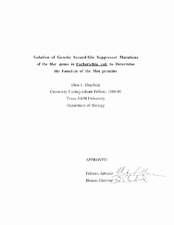Isolation of Genetic Second-Site Suppressor Mutations of the Mot genes in Escherichia coli to Determine the Function of the Mot proteins
| dc.contributor.advisor | Manson, Michael D. | |
| dc.creator | Graybeal, Dion F. | |
| dc.date.accessioned | 2022-04-01T16:04:03Z | |
| dc.date.available | 2022-04-01T16:04:03Z | |
| dc.date.issued | 1990 | |
| dc.identifier.uri | https://hdl.handle.net/1969.1/CAPSTONE-LovelaceL_1986 | |
| dc.description | Program year: 1989/1990 | en |
| dc.description | Digitized from print original stored in HDR | en |
| dc.description.abstract | Bacteria swim through their environment, but not that much is known about the "motor" which propels them. In Escherichia coli, a bacteria found in human intestines, six to eight flagella(4) move the cell around so that it can travel to "favorable environments." Both MotA and MotB, which are found in the cytoplasmic membrane (2, 11), form integral parts of this "motor," but in E. coli, it is not known what other proteins work in the motor. The motor is important because it transforms the electrochemical potential energy of H⁺ ions into a physical force on the molecular level. My research has revealed that there is a protein that interacts with MotA. | en |
| dc.format.extent | 23 pages | en |
| dc.format.medium | electronic | en |
| dc.format.mimetype | application/pdf | |
| dc.subject | Escherichia coli | en |
| dc.subject | flagella | en |
| dc.subject | MotA | en |
| dc.subject | MotB | en |
| dc.subject | electrochemical potential energy | en |
| dc.title | Isolation of Genetic Second-Site Suppressor Mutations of the Mot genes in Escherichia coli to Determine the Function of the Mot proteins | en |
| dc.type | Thesis | en |
| thesis.degree.department | Biology | en |
| thesis.degree.grantor | University Undergraduate Fellow | en |
| thesis.degree.level | Undergraduate | en |
| dc.type.material | text | en |


